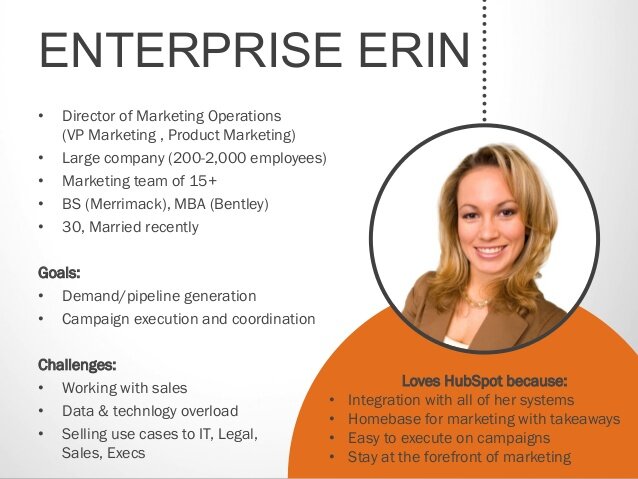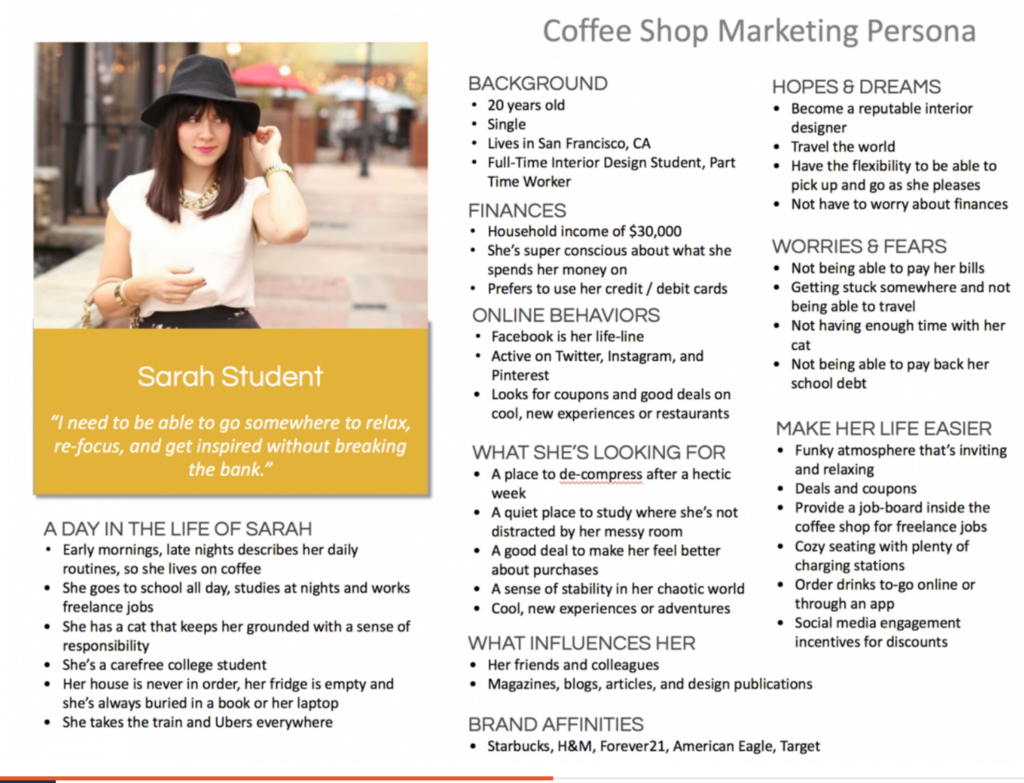How are you keeping your customer front-and-center as you prioritize product, marketing, and sales efforts? Are you and your team adept at understanding what drives your customers, what keeps them from reaching their goals, and why they seek you out in the first place?
This is where customer personas come in.
At their core, customer personas are archetypes. They represent the common traits of different prospective buyers and are based on quantitative and qualitative data. When personas are fully flushed out, marketers, salespeople, and product leads aren’t left making assumptions about who their customers are and what they need. Instead, they have data-driven profiles in place that guide business decisions and significantly increase the chances of hitting bullseyes with customers and prospects.
Why Do Persona Work
Much like branding efforts, persona work can often be considered a nice, fluffy activity that doesn’t move a business forward. Au contraire! Developing accurate personas (like investing in the right brand work) is the foundation for setting your product, marketing, and sales activities down the right path and optimizing your future customer acquisition costs and lifetime values. That’s because fully-flushed personas let you….
-
Keep Customers’ Needs & Everyday Challenges Front & Center: Those running product, marketing, and sales functions should make business decisions based on what is best for the customer. That means always keeping a pulse on what it is that could make their lives better and understanding how you can help solve their day-to-day challenges. Developing personas codifies these concepts and ensures that they stay central to your business strategy.
-
Prioritize Your Customer Target(s): You’ll generally find that a variety of different types of customers could purchase any given product or service. Which begs the question: who are you going to prioritize? Knowing your customer personas ensures that you’re not just being deliberate about who your efforts are targeting but that you simultaneously accept that other personas may not be as well served in the process.
-
Put A Face To Your Customers: It’s rare that the people working on the day to days of developing a product or service are exactly like the customers they sell to. Often, they are nothing alike. As a result, it can be all too easy to think of ourselves as the customer and forget about who the customer actually is. Having customer personas that can be looked at and talked about brings your customers to life and gives your team someone to rally around.
What Is A Customer Persona
Persona work usually yields templates that summarize key aspects of each customer persona. While they can certainly vary across industries, you’ll often see the following components:
-
Business / Life Challenges: We all have things that make our personal or professional lives challenging on a regular basis. It can be everything from time or resource constraints to working with difficult individuals or around bureaucratic processes. Uncovering what these challenges are helps keep top-of-mind the problems and issues you can help address with your product or service.
-
Business / Life Goals: Your customers come with pre-existing goals and aspirations. They may be concrete professional goals (e.g. drive revenue by X%, optimize a process by Y%). Conversely they could be personal aspirations (e.g. spending more time with family, owning a type of car). Goals help you know what is internally driving and motivating your personas and therefore help you prioritize which product, sales, or marketing activities make the most sense.
-
Purchase Drivers: There’s often some driver, external or internal, that leads customers to consider your product. Understanding these purchase drivers will help isolate what customers are truly trying to solve. While they no doubt have many challenges and goals, it’s the purchase drivers that are the impetus behind their initial consideration and should therefore be at the forefront of marketing and sales activities.
-
Purchase Obstacles: You’ll always want to take into account the concerns your customers may have around your product, or what factors will impede their purchase. Knowing these obstacles is critical to knowing what messaging, resources, or materials you’ll need to overcome them.
-
Key Influencers: Most individuals don’t make decisions in a vacuum. Whether it’s family and friends or managers and business associates, just about everyone is influenced by individuals around them. You’ll want to know who these influencers are so you can take them into account during the marketing and sales process as well as know how to leave a positive impression with them.
The final templates that are created summarize these components and make it easy to quickly glean what makes each persona unique. This is an example of what a persona template could look like for a B2B business…

Meanwhile, here’s an example of a template used in a B2C business.

How to Build Customer Personas
Quantitative, Data-Driven Persona Building: Often called customer segmentation, a quantitative, data-driven approach to persona building is the result of asking hundreds of customers or prospective customers many, many survey questions and then looking for patterns in how different groups respond to those questions. The end result is the development of distinct cohorts who turn into potential target customers. From those cohorts, usually one or two are selected as target personas.
-
Pros: Objectivity is the name of the game with the quantitative, data-driven approach to persona creation. This approach leverages statistical methods to identify personas, meaning that any existing internal bias is removed from the persona-creation process. Along the same lines is the caliber of the data you’re using to create your personas. This approach relies on very large survey sample sizes so you can feel confident that your personas are based on strong foundations.
-
Cons: What makes this approach so compelling is also what makes it so challenging: sample sizes. You need a lot of data to create personas with this approach. As a result, it is sometimes too difficult to find the number of respondents you need or too cost prohibitive.
Qualitative, Interview-Driven Persona Building: This approach requires going out and performing 1:1 interviews with customers and prospects. By asking the same questions time and again you can begin identifying patterns in responses and isolating key persona traits.
-
Pros: By seeking interviews with existing or prospective customers, you’re still leveraging independent data sources to identify patterns and drive your persona development. Additionally, you only need to perform about 10 interviews for each persona group you believe exists, a fairly manageable number.
-
Cons: Going into the qualitative approach, you need to have some sense of which personas you’ll be exploring. It could be personas based on job titles, frequency of purchase, total lifetime value, or some other notable characteristic. As a result, this approach accepts some subjectivity upfront in the persona development process. Further, because the number of interviews is generally limited, it’s possible, though not too likely, that a few unusual interviews can skew the final personas created.
Qualitative, Internally-Driven Persona Building: Creating personas internally means holding interviews with internal company stakeholders which can range from Founders and CEOs to frontline personnel like outbound and inside sales team members. Interviewing a variety of individuals that understand your market and general category, your core product and services, and, of course, how your customers view the category and make purchase decisions can help zero-in on key persona types.
-
Pros: This is often the easiest way to build personas. It leverages your core team, asks each participant to spend just a bit of time supporting your company’s broader strategy, and it can be executed fairly quickly. Additionally, by pulling information from team members that work with prospects and customers every day, such as members of your sales and customer success teams, you’ll be able to hear firsthand the needs and challenges faced by your buyers.
-
Cons: This is, arguably, the most biased approach to building personas. You’re relying on your team to tell you what your customer wants which means you’re hearing from your customers second hand and through a distilled lens. Additionally, you never know what you don’t know. It’s rare to proactively ask about customers’ hot button issues, professional and personal drivers, and barriers to purchase. As a result, relying simply on your team for persona building may result in valuable information left undiscovered.
Personas, An Ongoing Evolution
Marketing is rarely a “set it and forget it†type of activity. Persona building is no different.
While personas won’t change overnight, they will certainly evolve over time. To keep your finger on the pulse of whether or not it’s time to re-visit your persona work, consider what shifts, if any, have happened since you last did the analysis. For all types of organizations and businesses, major changes in market conditions—emerging technologies, societal/cultural shifts, recessions, etc.—often merit exploring your personas.
For B2B businesses specifically, revisiting personas can often happen if you’re seeing customers or inquiries coming from entirely new industries or if the type of person seeking you out (e.g. title, seniority) is changing. Meanwhile, for B2C businesses, it’s usually time to update personas if new competitors have hit the scene or if major changes have happened in your core category (e.g. product recalls, severe attitude changes about your category, etc.).
Keep in mind that doing persona work is about making sure that all of your marketing and sales activities resonate with your core audience. Checking your personas and updating them regularly is necessary to stay on top of customer needs and ensure that your acquisition and retention efforts actually are effective.





